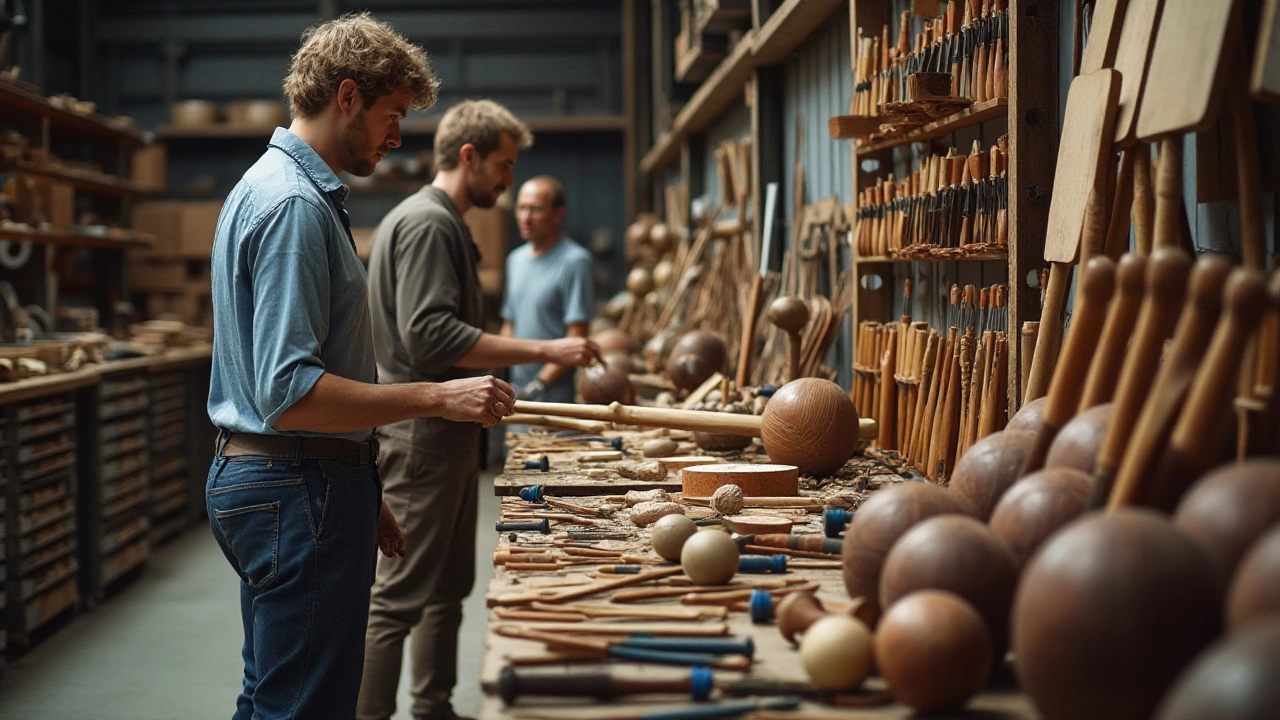Understanding Materials in Sports Equipment: What They're Made Of

In the world of sports, the materials that comprise the gear athletes use can make all the difference. Whether you're a weekend warrior or a professional competitor, understanding what your equipment is made of can enhance not just your performance, but your appreciation for the sport. From the grain of a wooden baseball bat to the cutting-edge composites in a modern bicycle frame, the materials define how the equipment behaves.
For centuries, natural materials like wood, leather, and animal bladders laid the groundwork for sports equipment. These materials are celebrated for their reliability and historical significance. However, as technology advanced, so did the materials available to equipment manufacturers. Fiberglass, carbon fiber, and plastics have revolutionized the gear, offering incredible strength while being lightweight.
The choice of materials doesn't just rest on performance, it also affects sustainability and cost. Manufacturers continuously explore innovative ways to blend traditional craftsmanship with modern discoveries. By doing so, they create not only more efficient equipment but also push the sporting world into new realms of possibility.
- Traditional Materials in Sports Equipment
- Role of Composites and Synthetics
- Innovations in Sports Gear Design
- Choosing the Right Equipment
Traditional Materials in Sports Equipment
When delving into the history of sports equipment, the foundational materials hold a tale that is as captivating as the games themselves. Long before the industrial age, artisans turned to the natural world to craft the tools of sport. Wood, for instance, is one of the earliest materials utilized, gracing the handles of bats, bows, and racquets for centuries. Its adaptability is unmatched, with different types of wood bringing unique benefits. Maple and ash, for example, are famous in baseball for their indispensable combination of strength and flexibility, helping players achieve that perfect swing.
Leather, too, has shared the spotlight, notably in crafting balls and protective gear. Its durability and pliability have made it a favourite. The robust exterior of a vintage leather football tells stories of matches long past, where every scuff is a mark of history. Leather’s natural property of becoming more supple with use made it an asset that was both protective and comfortable for the athletes from different disciplines, from boxing gloves to the saddles in equestrian sports.
Animal intestines, though not as common today, were originally used for making racquet strings and musical instruments. This unusual choice was born out of necessity and limited options, but it surprisingly offered excellent tension and resilience. As alternative materials emerged, the natural “gut” strings became a sought-after item, prized for their unique playability among tennis and squash players even today.
"The history of materials is the history of our interactions with the environment and our innovations," says Dr. Olive Harper, a historian of sports at the University of Toronto. "Each choice speaks to the sensory and practical engagements between athletes and their tools, a relationship as dynamic as the sports they enable."
These traditional materials were not chosen on a whim; their natural composition often provided the strength, weight, and tactile feedback that was intrinsic to the sports’ dynamics. For canoes and kayaks, wood like birch was preferred, celebrated for its buoyancy and ease of shaping. In early Amerindian cultures, birch bark was instrumental in crafting vessels that navigated the vast waterways, embodying not just utility but cultural heritage.
Through an artisanal lens, traditional materials also reflected the craftsmanship and skills passed down through generations. The function of each piece of sports equipment was deeply tied to the local resources available, underscoring an intimate connection between community and activity. By understanding this rich history, one appreciates the profound influence these original materials have had, shaping not just how sports were played, but how they were perceived and enjoyed across different cultures.

Role of Composites and Synthetics
The integration of composites and synthetics into the world of sports equipment has transformed how athletes experience their disciplines, offering magnified performance capabilities and broadening possibilities. One of the most notable benefits of using these advanced materials is their ability to combine strength with lightness, effectively elevating both the safety and efficiency of the equipment. Consider the evolution of tennis rackets: early models, crafted from wood, were heavy and limited in responsiveness. Today's rackets often utilize carbon fiber technology, making them significantly lighter yet incredibly robust, empowering players to exert more control and agility during matches.
Composites, such as fiberglass and carbon fiber, are engineered by layering different materials to create a final product that outperforms the properties of traditional single-material constructs. The versatility of these materials means they can be tailored to meet specific needs—offering different flexibilities, strengths, and energy efficiencies tailored to diverse sports. Skiers, for instance, benefit from the flexibility and lightness of composite-made skis, which significantly enhance maneuverability and speed on the slopes. Meanwhile, cyclists enjoy the aerodynamics and weight advantages of carbon fiber in bike frames, allowing longer rides with less effort.
Synthetics, like various types of plastics and rubber, provide additional options not only for performance but also for sustainability. Many manufacturers are now developing high-performance sports equipment with recycled materials, appealing to the eco-conscious athlete. The shift towards using such materials doesn't compromise the quality; instead, it often introduces improved durability and innovative design features. For example, performance sneakers use advanced foam polymers that offer superior cushioning and energy return, impacting athletes' comfort and endurance levels positively.
According to a study published by the National Institute of Standards and Technology, “The innovation of composite materials in sports equipment has boosted the mechanical performance by an average of 30% while reducing material weight significantly.” This reflects the industry-wide recognition of composites' potential to redefine sporting standards.
In the quest to find the perfect balance between tradition and innovation, manufacturers experiment continuously, pushing the limits of what composites and synthetics can achieve. Companies are now developing blends that optimize the strengths of multiple materials, ensuring athletes are equipped with gear that maximizes their potential. The future promises even smarter materials with embedded sensors and self-repair capacities, suggesting a burgeoning era where sports equipment will not only support but enhance an athlete’s natural capabilities.

Innovations in Sports Gear Design
Innovation in sports equipment is a testament to human ingenuity, driven by the desire to enhance athletic performance and safety. From the sleek lines of a high-tech bicycle helmet to the intelligently engineered football cleats, every piece of gear undergoes a meticulous design process. Let's take cycling helmets, for example. Traditional helmets were primarily hard shells with interior padding. Today, advanced materials like thermoplastic polycarbonate are coupled with multi-directional impact protection systems (MIPS) to better mitigate the impact, reducing concussion risks for cyclists.
Basketball has seen its own evolutionary leaps with the introduction of innovative materials in shoes and uniforms. The integration of lightweight synthetic materials has revolutionized footwear, combining qualities like breathability, flexibility, and support. Hyperfuse technology, developed by Nike, introduced layers of synthetic textiles fused together without stitches, drastically improving durability while maintaining lightness. Meanwhile, moisture-wicking fabrics have become standard in basketball apparel, keeping athletes dry and comfortable throughout the game.
Another area ripe with innovation is racket sports. The blend of graphite and carbon fiber in rackets, for instance, achieves an unparalleled balance between strength and weight. These materials allow for powerful swings without compromising control. Furthermore, innovations aren't exclusive to performance as sustainability emerged as a key focus. Companies are exploring alternative materials like biodegradable resins and recycled fibers.
"Material innovation in sports equipment is not just about performance. It's about creating gear that stands its ground on environmental responsibility," noted sports technologist Dr. Paxton Harris.
Looking at team sports, equipment managers have increasingly shifted their focus to player safety, and this has become a fertile ground for innovation. In football, for instance, chip technology embedded in pads and uniforms helps track player movements and fatigue levels, offering insights into both player performance and potential injuries. These technologically enhanced wearables provide coaches and medical staff with critical data otherwise unavailable.
Technological advancements go beyond traditional sports and venture into e-sports, where gear design is matching the virtual experience with reality. Haptic feedback devices, ergonomically designed for gamers, replicate the sensation of touch and interaction within video games. This represents the cutting-edge realm where gaming peripherals are being developed – something as simple as a mouse or a keyboard now has layers of professional-grade engineering behind it.
Innovation often draws inspiration from cross-industry technologies. The adaptation of aerospace materials like carbon nanotube-infused polymers into sports gear showcases how seemingly unrelated industries propel advancements by sharing technologies. The benefits of these materials are substantial, providing increased tensile strength while reducing weight, similar to their application in aviation where weight reduction equates to fuel efficiency. Such an interdisciplinary exchange of ideas only serves to push the boundaries of what sports gear can achieve, continually refining the athlete's toolkit.

Choosing the Right Equipment
When it comes to selecting the best sports equipment for your needs, the myriad of options available can be daunting. The first step is to consider the sport you're engaging in, as each one demands specific characteristics from its gear. For instance, the materials used in a tennis racket will differ from those in a cricket bat, primarily due to the need for different levels of flexibility, strength, and weight. Consider your skill level and how intensively you'll be using the equipment. A beginner might not need the advanced technology present in professional-grade gear, and investing in high-end equipment could not only be wasteful but might also hinder skill development. Your athletic goals will also guide your choices, determining whether you lean towards durable longevity or superior performance enhancements from your equipment.
Understanding the materials used in the manufacturing of sports gear is vital. For casual players, standard materials may suffice, but advanced players often seek equipment made from cutting-edge composites that offer benefits like enhanced aerodynamics or reduced weight. For example, modern golf clubs frequently incorporate carbon fibers, not only for their lightweight properties but also for the remarkable energy transfer they offer upon impact. Similarly, choosing the right soccer ball might involve an inspection of the outer material, be it traditional leather for better feel or synthetic alternatives that offer easier maintenance and longer life. When the opportunity to consult with coaches or seasoned players arises, it can offer invaluable insights. These individuals might share personal experiences, which could guide you away from common pitfalls or advocate for specific brands based on durability and performance.
John Wooden, one of the most renowned coaches in basketball history, once said, "Things turn out best for the people who make the best of the way things turn out." This underscores the idea that choosing the right equipment involves making informed, thoughtful decisions.
Budget considerations inevitably come into play when selecting sports equipment. Higher costs often correlate with more specialized materials and advanced technology, though that's not to say that excellent performance can't be found at every price point. Conducting thorough research and reading reviews from other athletes can reveal equipment that offers excellent value for money. Some may find significant savings by purchasing items from previous seasons as advancements in material technology don't render last year's models ineffective. Often, slight differences between iterations mean an older model can serve just as well without the hefty price tag of brand-new releases. The durability of materials also plays a crucial role in purchasing decisions. Spending a little more initially could save a lot in replacements down the line, especially for frequently used equipment subjected to high-wear situations, such as running shoes made from performance-enhancing composites like thermoplastic polyurethane (TPU) which offers longevity and cushioning.
Testing and Trying
If possible, try out the equipment before purchasing, as comfort and fit can vary widely even among similar products. Many stores offer demo days or rental options—especially for high-investment items like basketball shoes or snowboards—which allow you to test various brands and styles under real conditions. It's not uncommon for a piece of equipment to meet all technical specifications yet feel wrong during use. Personal preference is a critical yet subjective measure of how well gear will work for you. A racket that feels perfect in another player's hands may not balance well for you, and these nuances are often only unveiled through practical experience. Don't rush the decision—taking the time to thoroughly test equipment will lead to choices that enhance your performance and enjoyment in any sport.



